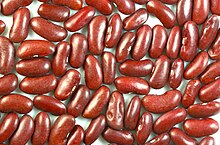Kidney bean
The kidney bean is a variety of the common bean ( Phaseolus vulgaris ). It is named after the kidney because of its visual similarity in shape and color ('kidney' = English for kidney). Red kidney beans should not be confused with the adzuki bean ( Vigna angularis ) and the fire bean ( Phaseolus coccineus ).
Origin and cultivation
There is evidence that the kidney bean comes from Peru and found its way to Europe during colonial times . It is now also known in Asia. Like all other beans, the kidney bean also needs a humid climate for growth , which is why the bean is mainly grown in Africa and America. But they are now common in China too.
Appearance, taste and texture
Kidney beans are dark red legumes with a kidney-like shape. Because of the color, they are also known as red beans. Accordingly, not all beans are created equal, as they all differ significantly in terms of color, shape and taste.
Kidney beans contain phytohemagglutinin , so they should only be consumed cooked. It will be different than z. B. With green beans, only the bean kernels are consumed without pods.
Kidney beans are soft and slightly floury and have a slightly sweet taste. In addition, they can be easily added to other dishes as they take on the aroma of other ingredients relatively easily.
composition
The composition of kidney beans depends on the environmental conditions (soil, climate), the cultivation technique (fertilization, plant protection) and the processing of the beans.
Kidney beans are made up as follows (average data per 100 g edible portion):
|
|
|
|
1 mg = 1000 µg
The physiological calorific value is 532 kJ (127 kcal) per 100 g of edible portion.
Web links
Individual evidence
- ↑ FDA: Bad Bug Book: Foodborne Pathogenic Microorganisms and Natural Toxins Handbook Phytohaemagglutinin. ( Memento of March 8, 2013 in the Internet Archive )
- ↑ FDC: Beans, kidney, red, mature seeds, cooked, boiled, without salt , March 2020
